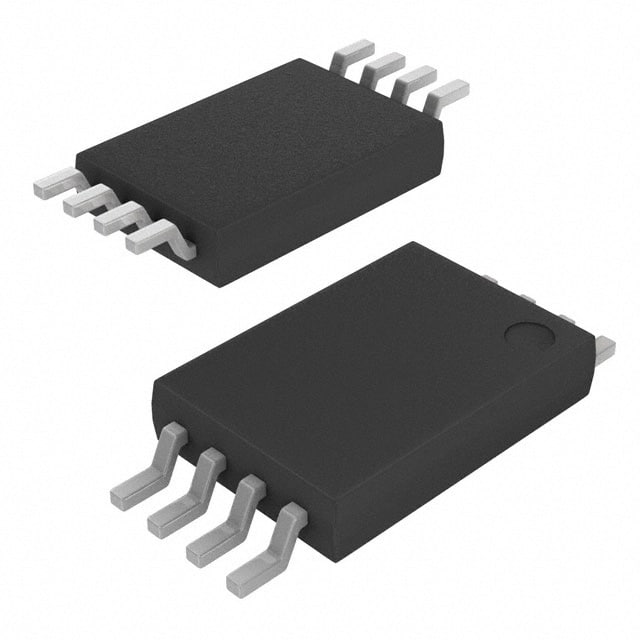Viz Specifikace pro podrobnosti o produktu.

S-24C08DI-T8T1U5
Basic Information Overview
Category: Integrated Circuit (IC)
Use: Data storage and retrieval
Characteristics: - Non-volatile memory - Serial EEPROM (Electrically Erasable Programmable Read-Only Memory) - 8K-bit capacity - I2C (Inter-Integrated Circuit) interface - Low power consumption - High reliability
Package: TSSOP-8 (Thin Shrink Small Outline Package)
Essence: S-24C08DI-T8T1U5 is a serial EEPROM IC used for storing and retrieving data in various electronic devices.
Packaging/Quantity: The S-24C08DI-T8T1U5 IC is typically sold in reels or tubes, with each reel/tube containing a specific quantity of ICs. The exact packaging and quantity may vary depending on the manufacturer.
Specifications
- Capacity: 8K bits (1024 bytes)
- Interface: I2C (2-wire serial interface)
- Supply Voltage: 1.7V to 5.5V
- Operating Temperature Range: -40°C to +85°C
- Write Cycle Endurance: 1 million cycles
- Data Retention: 100 years
Detailed Pin Configuration
The S-24C08DI-T8T1U5 IC has a total of 8 pins, which are as follows:
- VCC: Power supply voltage input
- SDA: Serial data input/output pin for I2C communication
- SCL: Serial clock input pin for I2C communication
- WP: Write Protect pin (optional, can be connected to VCC or GND)
- A0: Address bit 0 (used for device addressing)
- A1: Address bit 1 (used for device addressing)
- GND: Ground connection
- NC: No Connection (unused pin)
Functional Features
- Byte-wise Read and Write operations
- Page Write mode for faster data transfer
- Software Write Protection using the WP pin
- Hardware Write Protection using the I2C protocol
- Sequential Read mode for efficient data retrieval
- Acknowledge polling for reliable communication
- Start and Stop conditions for I2C bus control
Advantages and Disadvantages
Advantages: - Non-volatile memory ensures data retention even when power is lost - Low power consumption, suitable for battery-powered devices - High reliability with a long data retention period - Compact package size for space-constrained applications - Easy integration into existing I2C bus systems
Disadvantages: - Limited storage capacity compared to other memory technologies - Slower write speed compared to some other memory types - Vulnerable to electromagnetic interference (EMI) due to its serial nature
Working Principles
The S-24C08DI-T8T1U5 IC utilizes EEPROM technology to store and retrieve digital data. It employs an I2C interface for communication with the host microcontroller or system. The IC can be addressed using the A0 and A1 pins, allowing multiple devices to be connected on the same I2C bus.
Data can be written to the IC byte by byte, or in page write mode for faster transfer. The WP pin provides write protection, preventing accidental modification of stored data. The IC supports sequential read mode, enabling efficient retrieval of consecutive data bytes.
Detailed Application Field Plans
The S-24C08DI-T8T1U5 IC finds applications in various electronic devices that require non-volatile data storage. Some common application fields include:
Consumer Electronics:
- Smartphones and tablets
- Digital cameras
- Set-top boxes
Automotive:
- Engine control units (ECUs)
- Infotainment systems
- Dashboard displays
Industrial Automation:
- Programmable logic controllers (PLCs)
- Human-machine interfaces (HMIs)
- Data loggers
Medical Devices:
- Patient monitoring systems
- Portable medical equipment
- Implantable devices
Detailed and Complete Alternative Models
- S-24C08DI-T8T1U5A: Similar to S-24C08DI-T8T1U5, but with extended temperature range (-40°C to +105°C).
- S-24C08DI-T8T1U5B: Similar to S-24C08DI-T8T1U5, but with higher capacity (16K bits).
- S-24C08DI-T8T1U5C: Similar to S-24C08DI-T8T1U5, but with lower power consumption.
These alternative models offer variations in temperature range, capacity, and power consumption to cater
Seznam 10 běžných otázek a odpovědí souvisejících s aplikací S-24C08DI-T8T1U5 v technických řešeních
Sure! Here are 10 common questions and answers related to the application of S-24C08DI-T8T1U5 in technical solutions:
Q1: What is S-24C08DI-T8T1U5? A1: S-24C08DI-T8T1U5 is a specific model of an I2C-compatible EEPROM (Electrically Erasable Programmable Read-Only Memory) chip.
Q2: What is the capacity of S-24C08DI-T8T1U5? A2: The S-24C08DI-T8T1U5 has a capacity of 8 kilobits, which is equivalent to 1024 bytes or 1 kilobyte.
Q3: What is the operating voltage range for S-24C08DI-T8T1U5? A3: The operating voltage range for S-24C08DI-T8T1U5 is typically between 1.7V and 5.5V.
Q4: How can S-24C08DI-T8T1U5 be interfaced with a microcontroller? A4: S-24C08DI-T8T1U5 uses the I2C protocol for communication, so it can be easily interfaced with a microcontroller using the I2C bus.
Q5: What is the maximum clock frequency supported by S-24C08DI-T8T1U5? A5: The maximum clock frequency supported by S-24C08DI-T8T1U5 is 400 kHz.
Q6: Can S-24C08DI-T8T1U5 be used for storing program code? A6: Yes, S-24C08DI-T8T1U5 can be used for storing program code, configuration data, or any other non-volatile data in a microcontroller-based system.
Q7: Is S-24C08DI-T8T1U5 suitable for high-temperature applications? A7: Yes, S-24C08DI-T8T1U5 is designed to operate reliably in a wide temperature range, typically from -40°C to +85°C.
Q8: Does S-24C08DI-T8T1U5 support write protection? A8: Yes, S-24C08DI-T8T1U5 supports software write protection by using specific commands to enable or disable write access to the memory.
Q9: Can multiple S-24C08DI-T8T1U5 chips be connected on the same I2C bus? A9: Yes, multiple S-24C08DI-T8T1U5 chips can be connected on the same I2C bus by assigning unique addresses to each chip.
Q10: What are some typical applications of S-24C08DI-T8T1U5? A10: S-24C08DI-T8T1U5 is commonly used in various applications such as industrial control systems, consumer electronics, automotive electronics, and medical devices for storing small amounts of non-volatile data.
Please note that the answers provided here are general and may vary depending on the specific requirements and implementation of the technical solution.

